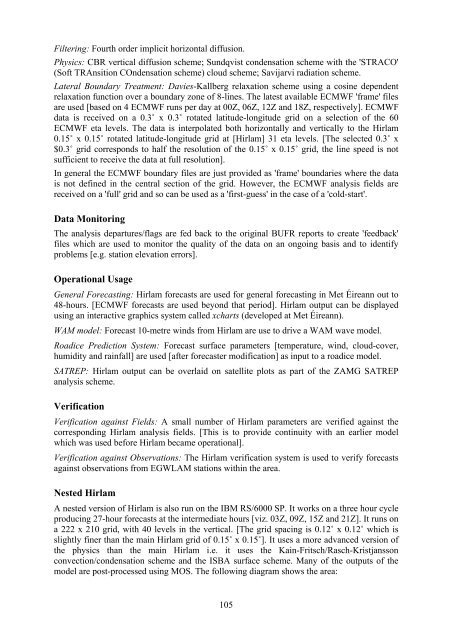Proceedings - C-SRNWP Project
Proceedings - C-SRNWP Project
Proceedings - C-SRNWP Project
You also want an ePaper? Increase the reach of your titles
YUMPU automatically turns print PDFs into web optimized ePapers that Google loves.
Filtering: Fourth order implicit horizontal diffusion.<br />
Physics: CBR vertical diffusion scheme; Sundqvist condensation scheme with the 'STRACO'<br />
(Soft TRAnsition COndensation scheme) cloud scheme; Savijarvi radiation scheme.<br />
Lateral Boundary Treatment: Davies-Kallberg relaxation scheme using a cosine dependent<br />
relaxation function over a boundary zone of 8-lines. The latest available ECMWF 'frame' files<br />
are used [based on 4 ECMWF runs per day at 00Z, 06Z, 12Z and 18Z, respectively]. ECMWF<br />
data is received on a 0.3˚ x 0.3˚ rotated latitude-longitude grid on a selection of the 60<br />
ECMWF eta levels. The data is interpolated both horizontally and vertically to the Hirlam<br />
0.15˚ x 0.15˚ rotated latitude-longitude grid at [Hirlam] 31 eta levels. [The selected 0.3˚ x<br />
$0.3˚ grid corresponds to half the resolution of the 0.15˚ x 0.15˚ grid, the line speed is not<br />
sufficient to receive the data at full resolution].<br />
In general the ECMWF boundary files are just provided as 'frame' boundaries where the data<br />
is not defined in the central section of the grid. However, the ECMWF analysis fields are<br />
received on a 'full' grid and so can be used as a 'first-guess' in the case of a 'cold-start'.<br />
Data Monitoring<br />
The analysis departures/flags are fed back to the original BUFR reports to create 'feedback'<br />
files which are used to monitor the quality of the data on an ongoing basis and to identify<br />
problems [e.g. station elevation errors].<br />
Operational Usage<br />
General Forecasting: Hirlam forecasts are used for general forecasting in Met Éireann out to<br />
48-hours. [ECMWF forecasts are used beyond that period]. Hirlam output can be displayed<br />
using an interactive graphics system called xcharts (developed at Met Éireann).<br />
WAM model: Forecast 10-metre winds from Hirlam are use to drive a WAM wave model.<br />
Roadice Prediction System: Forecast surface parameters [temperature, wind, cloud-cover,<br />
humidity and rainfall] are used [after forecaster modification] as input to a roadice model.<br />
SATREP: Hirlam output can be overlaid on satellite plots as part of the ZAMG SATREP<br />
analysis scheme.<br />
Verification<br />
Verification against Fields: A small number of Hirlam parameters are verified against the<br />
corresponding Hirlam analysis fields. [This is to provide continuity with an earlier model<br />
which was used before Hirlam became operational].<br />
Verification against Observations: The Hirlam verification system is used to verify forecasts<br />
against observations from EGWLAM stations within the area.<br />
Nested Hirlam<br />
A nested version of Hirlam is also run on the IBM RS/6000 SP. It works on a three hour cycle<br />
producing 27-hour forecasts at the intermediate hours [viz. 03Z, 09Z, 15Z and 21Z]. It runs on<br />
a 222 x 210 grid, with 40 levels in the vertical. [The grid spacing is 0.12˚ x 0.12˚ which is<br />
slightly finer than the main Hirlam grid of 0.15˚ x 0.15˚]. It uses a more advanced version of<br />
the physics than the main Hirlam i.e. it uses the Kain-Fritsch/Rasch-Kristjansson<br />
convection/condensation scheme and the ISBA surface scheme. Many of the outputs of the<br />
model are post-processed using MOS. The following diagram shows the area:<br />
105

















